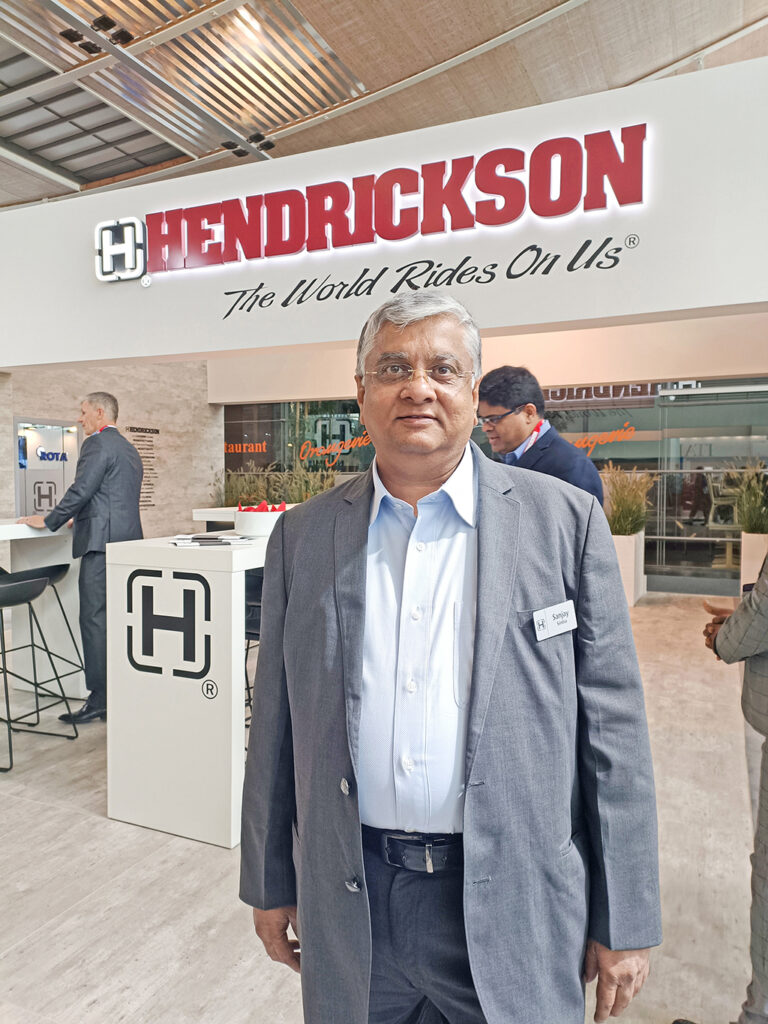Rajesh Rajgor speaks exclusively with Sanjay Sinha, CEO of Tata Autocomp Hendrickson Suspensions, at the Hendrickson pavilion at IAA 2022 to learn what sets the business and its products apart from the competition

Communication at IAA 2022
When it comes to technology, our primary focus is on providing the edge on light-weighting from the end user’s or the actual customer’s standpoint. Our products require very little, if any, maintenance, and, more importantly, there is no grease. They are also quite durable. There is no downtime, and from the standpoint of the end user, the greatest is that we provide a warranty of over four years. Some of our products have achieved more than 7,000 hours in the tipper market. It lends legitimacy to our clients’ experience of our comfort and toughness.
Reliable ULTIMAAX
We are delivering products that are compatible with the Indian market. We are integrating and mending it in India as per Indian road usage. You are aware that ULTIMAAX was introduced in 2016. Unfortunately, the pandemic caused an industry slowdown that lasted for 2.5 years, but the product has recovered well due to a number of highly special factors, including its light weight, high durability, low maintenance requirements, lack of grease and four-year warranty. Operators have truly needed this, and fleets have benefited.
If you look at the mining industry in India, it typically works six to eight months out of the year because the rest of the time the mines are submerged in water and not much work gets done. However, while they are working, they require an uninterrupted performance for at least 20-22 hours. The load rating is increasing along with the change in axle requirements. Although overload is common in India, as you are aware, this suspension is one of the newest, and we introduced it as a more sophisticated version ULTIMAAX.
Innovative Products
We increased the wheel spacing from the standard 1,350 to 1,830, which will enable two more tonne loads to be delivered to the trucking portion of it. This is the only option to address the issue. We have included some more recent technologies, such as that for 9 meter buses. We have solidified our position as a market leader in the EV sector. The battery goes up on the roof and when the battery rises up, the roll becomes very significant. These are the first two things in the EV segment. Therefore, that amount of roll resistance is provided by our product. Secondly, EV buses offer a comfortable experience while making hardly any noise in the surrounding area.
Therefore, we are transitioning to 12 metres after already serial producing our EV bus product for 9 metres. When it comes to the composite spring, another very significant technological advancement is that we are currently in a series supply with one of the big OEMs and the composite spring is performing beautifully. One transverse spring will replace the longitudinal spring in the front, and the performance will be simply fantastic thanks to the computer design. Another 12-meter bus suspension that can support a load of up to 13 tonnes per axle is currently being developed.
Outlook for Different Segments
I will break it down segment by segment so you can see how the market is feeling and how things are currently moving. It is well-known that the industry is set to invest close to Rs 50,000 crore in the bus market. Within the next three to five years, close to 45,000 to 50,000 new buses will be operating on the roadways. STUs no longer purchase buses; instead, they facilitate the industry, which will be more at the level of operating costs. The main concern in a tender-based discussion is how to lower the operating cost when OEMs or service providers must work at operating cost levels.
Here, we play a significant part in ensuring that our product provides a very high life with minimal maintenance. When a bidder wins the contract based on operational costs, he seeks to cut expenses while working with the suppliers of aggregates that provide bus items. This is where we step in and observe a very strong positioning for those products. Secondly, let me tell you that the second phase of BS VI is approaching in April. The price will rise even more as a result. Once again, the same issue arises: fleets are seeking for ways to lower operating costs as the cost of vehicles rises. This operational cost reduction is made possible by products like ours, which offer substantially bigger payloads without sacrificing any part of the product’s maintenance or serviceability. So, these factors contribute to its reduction.
The Indian commercial vehicle market is opening up for technology, which is what makes me feel good about it. Our work on a product like composite, which had never been done before, is now available in series. People were quite sceptical about a monolith suspension that was being put into trucks: could a single leaf survive in commercial vehicles? Yes, that is entering the commercial vehicle segment today. I observe adaptability in the Indian commercial vehicle market as well, where individuals are searching for better technologies that would enable them to increase operational effectiveness.